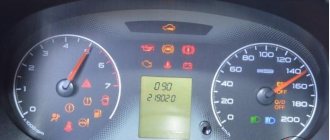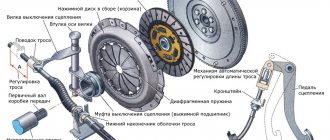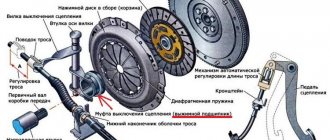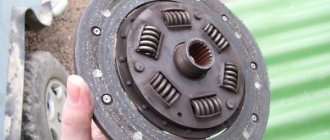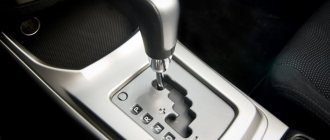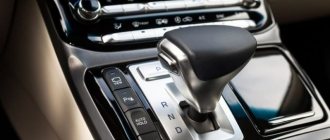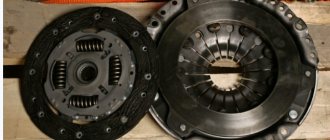06 September 2017 Lada.Online 86 519 13
The main distinguishing feature of an automated transmission (AMT or “robot”) from a mechanical one is the electric actuators produced by ZF, which change gears at the command of the electronic “brains”. The manufacturer claims that the actuator unit is maintenance-free and cannot be repaired, but craftsmen have found a way to repair it with their own hands.
If the car’s warranty has already expired, then replacing the clutch release mechanism actuator yourself will cost tens of thousands of rubles (article numbers: 21820160901200 and 21820170501200). In an attempt to save money, you can try to repair it.
Replacement and repair of the AMT clutch actuator on LADA
The main distinguishing feature of an automated transmission (AMT or “robot”) from a mechanical one is the electric actuators produced by ZF, which change gears at the command of the electronic “brains”.
The manufacturer claims that the actuator unit is maintenance-free and cannot be repaired, but craftsmen have found a way to repair it with their own hands. If the car’s warranty has already expired, then replacing the clutch release mechanism actuator yourself will cost tens of thousands of rubles (article numbers: 21820160901200 and 21820170501200). In an attempt to save money, you can try to repair it.
Design and operating principle of AMT
In general terms, AMT is a conventional manual transmission in which two special actuators (servo drives) are responsible for clutch operation and gear shifting. Each actuator installed on the gearbox is an electric motor with a gearbox and an actuator. The entire system is controlled by an electronic unit that selects and engages the required gear.
New LADA Granta on robot
The electronic unit takes into account the vehicle speed and engine operating mode, as well as information received from systems that monitor traffic safety (ABS, BAS, EBD, etc.). Evaluating and analyzing all the information received, the electronics unit issues a command to change gear.
Replacing the AMT clutch actuator
- Disconnect the negative terminal of the battery.
- The engine air filter has been removed.
- Remove the screw securing the wiring harness.
- Remove the three screws securing the AMT actuator unit.
All that remains is to disconnect the connector (press the fasteners, the direction is indicated by the arrow) and pull the actuator out through the top.
Install actuator 1, Figure 8-6, clutch release on bracket 3 and tighten three self-tapping screws 2. Screw tightening torque 7. 12 N.m (0.7. 1.2 kgf.m) (replaceable attachment Torx T30, knob, torque wrench).
Attach block 4, Figure 8-5, of the additional wiring harness to connector 2 of actuator 1 of the clutch release mechanism and secure the harness to bracket 3 with two fastening brackets 6.
Install actuator 3, Figure 8-4, clutch release assembly with bracket and additional wiring harness on the gearbox, install the outlet hose bracket on the actuator bracket and tighten, without tightening, two bolts 2 and nut 4 of the fastening (replaceable head 13, knob).
Adjust the extension of rod 6, Figure 8-7, of the actuator, for which you need to:
- move the actuator 5 in the direction of the arrow until the rod 6 touches the clutch release fork 7 and mark the position of the bracket 4 relative to the gearbox using a non-stress method.
- using the mark, additionally move the actuator in the direction of the arrow by an amount of 6±2 mm and finally tighten two bolts 1 and 2 and fastening nut 3. The tightening torque of the bolts and nuts is 16...25 N.m (1.6...2.5 kgf.m) (replaceable head 13, wrench, torque wrench, ruler or caliper).
Figure 8-7 — Installation of the clutch release mechanism actuator: 1,2 — bolts securing the actuator to the gearbox; 3 — nut securing the actuator to the gearbox; 4 — actuator mounting bracket: 5 — clutch release actuator; 6 — actuator rod; 7 — clutch release fork
Connect the additional wiring harness connectors to the gear shift actuator connectors, the control controller connector, and the input shaft speed sensor.
Secure the additional wiring harness with brackets built into the harness to the radiator outlet hose, to the left engine mount bracket and to the fan housing.
Also, the process of removing and installing the clutch release mechanism actuator is described in TI 3100.25100.20583 (download).
Why does the Vesta clutch actuator creak and how to eliminate it on your own?
Annoying sounds from the mechanism for controlling the position of the friction discs, as well as vibration of engines 21129 and 21179 at idle, usually appear after the break-in is complete. Most often, the specific acoustic design of transition modes occurs between 20,000 and 30,000 km.
Cause
At first, the defect appears inconsistently. Usually the clutch squeaks slightly in dry, warm weather, as well as in cold weather. This behavior is evidence that there is not enough lubrication on the rubbing surfaces. It is at this stage that you already need to think about how to lubricate the clutch actuator on Vesta or what lubricant to buy. Ignoring the initial symptoms is unacceptable - the effect will only intensify, manifesting itself in any weather conditions.
Dealers are reluctant to replace the actuator due to creaking. In most cases, representatives of the technical center activate a program to request the plant about the causes of the malfunction. The process is long and not always effective. Only a small percentage of dealerships will unconditionally replace the servo with a new one.
It is expensive to change the mechanism at your own expense - the price for a clutch actuator is at least 13,500 rubles. However, it is unlikely that it will be possible to find a new one yet - due to their scarcity, they are supplied only to officials.
How to fix
The manufacturer of electric actuators for Lada Vesta, represented by ZF, confidently declares that the drive is maintenance-free. If the clutch squeaks, he recommends replacing the assembly. Craftsmen think differently - the servo drive can be disassembled and lubricated. At specialized service stations, a corresponding service has even appeared, the price of which is from 2,000 to 3,000 rubles.
Tool
When performing the operation, you will not need any exclusive devices. An ordinary “garage first aid kit” will be sufficient at all stages of dismantling and assembling the unit:
- Ratchet crank.
- Screwdriver for bits or screwdriver.
- Heads for “10” and “13”.
- Open-end wrenches for “13” and “27”.
- Attachments for a screwdriver or screwdriver Torx 20, 30.
It is convenient to carry out manipulations to eliminate the creaking of the Lada Vesta clutch actuator on a lift, overpass or pit. If there are no such means nearby, you can use a good rolling jack and safety stands.
Dismantling method
All work on applying the lubricant is carried out exclusively on the dismantled servo drive. Although access is limited, the assembly is easy to remove. Getting to the inside of the structure is also easy.
Important! Further measures are carried out with the negative terminal of the battery disconnected. The system does not identify dismantling, therefore, there will be no need to perform adaptation (setting up the drive using a computer).
The initial task is to free up space around the device. Two elements must be dismantled: the air filter housing and the engine crankcase protection. The actuator itself is mounted on a black bracket. It is more convenient to remove the drive assembled with the fastening element using the following method:
- Disconnect the power strips (one is located on top, the other on the bottom). This is easier to do with the wiring fasteners unscrewed.
- Unscrew two nuts from the hood side and two from under the bottom.
- Remove the assembly.
Disassembling the electromechanical drive involves disconnecting the bracket and removing the cover. All parts are secured with Torx screws. You can unscrew them quickly and conveniently using a screwdriver.
Disassembling the AMT clutch actuator
Unscrew the top cover. We “discharge” the actuator (turn the gear as in the video) and remove the cover (do not open without the clutch load).
Remove the white compensator (Caution! The spring is very powerful!). The thrust rod is simply removed with force.
When assembling, carefully “cock” the mechanism (photo 1 - unloaded, photo 2 - cocked).
There is no need to make any adjustments to the clutch actuator after installation on the vehicle.
AMT clutch actuator repair
Clean the inner surface with solvent. Let's examine the insides. In this example, wear on the ball stops and a crack on the plastic part of the actuator were detected. The problem is that there are no repair kits. That is, AMT clutch actuator parts are not sold separately. If you cannot restore the old ones, all that remains is to lubricate the mechanism.
LIQUI MOLY Thermoflex Spezialfett was used as actuator lubricant. It is very similar to the one that was in the actuator from the factory. Read more about actuator lubrication here.
We perform reassembly and installation of the AMT actuator on the car (see above).
Let us remind you that if other malfunctions occur in the operation of the AMT (howling, crackling, the car jerks, jerking, rattling, etc.), you can determine the cause using these instructions.
Share on social networks:
Found an error? Select it and press Ctrl+Enter..
Source
Actuator lubrication Lada Vesta
How to carry out the procedure yourself? Lubrication requirements
A robotic gearbox, also called an automated manual transmission (AMT), combines the comfort of an automatic with the reliability and fuel efficiency of a manual.
However, the operating experience of AMT shows that failures also occur in its operation. The most common problem is a squeaking sound when changing gears. The reason for this phenomenon is the gradual depletion of lubricant in the clutch actuator.
This mechanism is an electromechanical device designed to compress the spring of the release disk.
If there is a lack of lubrication in the actuator gearbox, not only extraneous noise occurs, but also shocks, and the time interval between gear changes increases.
Disassembling the clutch mechanism and lubricating the actuator helps solve this common problem. This is much cheaper than replacing the entire assembly.
Let's look at how to carry out this procedure yourself using the example of a Lada Vesta car equipped with AMT.
How to adapt the AMT (“robot”) LADA with your own hands
Adaptation of the automated transmission (AMT) is necessary for the correct operation of the clutch release actuator. If this operation is not performed, then malfunctions in the operation of the transmission may occur (jerks, jolts while driving, as well as increased wear of the clutch). AMT adaptation should be performed as the clutch wears out or after replacing it. You can perform AMT adaptation at the LADA dealership or yourself.
Attention! You perform all actions at your own peril and risk. The instructions were written not by specialists/engineers, but from the words of owners of Lada Vesta and Lada XRAY cars (SrgKlsnkv and sva775). The procedure was not tested on other LADA models with AMT (Granta, Kalina, Priora).
Conditions for completing the training procedure
:
- battery voltage > 10 V;
- temperature of the actuator electric drives, training of the final positions of the clutch actuator. Execution time is about 5-6 seconds. (you will hear the actuator moving).
- After the operation, press the “STOP” button and turn off/on the ignition.
- We wait 5-10 seconds and start the gearbox learning
. We do not turn off the ignition. Execution time is about 1 minute. - After the operation, press the “STOP” button and turn off/on the ignition.
- Start the engine and wait 15-20 seconds, then start learning the clutch touch point
. Execution time 5-10 seconds. - After the operation, press the “STOP” button and turn off the ignition. Wait for the main relay to turn off (about 4 minutes)
- We start the engine and check.
Lada Vesta repair books
Products from the Dustershop77 range on the topic of the article:
NameManufacturerPriceAvailabilityAdd to cartDC952-7703062062Gearbox drain plug gasket, transfer case Renault Duster / Terrano / Captur original 7703062062Original200 / 100 rub. Discount: 50 rub. 5DC1560-8200884113 Drive oil seal original Renault 8200884113 left Original 1000 / 800 rub. Discount: 700 RUR 2DC524-302054100RClutch kit for 1.6 (H4M) 4×2 gearbox JR5 (5-speed) original art. 302054100ROriginal8000 / 7400 rub. Discount: 7000 rub. 1DC1630-7703075180 Filler plug for gearbox / transfer case original 7703075180 Original 200 / 150 rub. Discount: 100 rub. 4DC1667Vesta clutch kit (1.6l 21129 + manual transmission VAZ / AMT) LUKanalog5500 / 4600 rub. Discount: 4400 RUB 2DC422-510009710 Release bearing H4M 4×2 JR5/JH3 5-speed. LUK 510009710 306200650R 7701478631 8200046103 8200764613 8200990502 306205482R 306205482R 306206219R 306201586RAanalogue4500 / 3900 r. Discount: RUB 3,500 2DC440-8200410813 Drive shaft retaining ring original art. 8200410813Original500 / 300 rub. Discount: 250 rub. 3DC383-ASAM-30799 Gear shift lever bushing ASAM-SA 30799 original art. 7700732903 Analog 400 / 150 rub. Discount: 100 rubles 1DC1631-8200201381Gearbox/transfer case filler plug gaskets original 8200201381Original 500/350 rubles. Discount: 300 rub. 3DC956-7700102458 Automatic transmission filter DP2 original 7700102458 Original 900 / 600 rub. Discount: 500 rub. 135025 Repair book for VAZ LADA VestaРФ1500 / 1300 rub. Discount: 1200 RUR 1DC950-321031MG0B Rear gearbox plug Renault Duster / Captur / Nissan Terrano 4x4 filler 321031MG0BOriginal 1000 / 800 RUR Discount: 700 rub. 2DC1316-8201630012 Guide (tool) for centering the clutch and release (H4M-JR5/JH3) original 8201630012 Original 2000 / 1800 rub. Discount: 1600 rub. 1DC1963-21102301035 Left drive oil seal Vesta, Largus, X-Ray article 21102301035 (red 35x57x9) Original 200 / 120 rub. Discount: 90 rub. 135026 Repair book for VAZ LADA Xray RF1700 / 1500 rub. Discount: 1300 rub. 1DC1818-7701209239 Boot of outer CV joint Duster, Terrano, Captur 1.6 / 1.5 4×4 manual transmission 7701209239 originalOriginal 3200 / 2500 rub. Discount: 1900 RUR 1DC1956-21820160121100 Clutch fork boot Grant, Vesta, X-Ray 21820160121100Original 150 / 100 RUR Discount: 70 rub. 1DC1964-21102301034 Right drive oil seal Vesta, Largus, X-Ray article 21102301034 (black 35x57x9) Original 200 / 120 rub. Discount: 80 RUR 1DC2046-8200544206Input shaft oil seal for gearbox TL4/TL8/JR5 8200544206Original1000 / 700 RUR Discount: 500 rub. 1DC2159-6001548446 Clutch master cylinder Duster and others original 6001548446 Original 4600 / 4200 rub. Discount: RUB 3,900 1DC2163 Clutch basket Vesta, X-Ray 1.8 21179 JR5 original 21179-1601085-10Original RUB 7,300 / 6,500 Discount: 6100 RUR 1DC2164 Clutch disc Vesta, X-Ray 1.8 21179 JR5 original 21179-1601130-11Original 6400 / 5300 RUR Discount: 4900 rub.1Via phone
- For an Android smartphone, download and install the ECU Tweaker application. We copy the ecu.zip archive to the root of the internal or external memory without unpacking it.
- Connect the ELM327 V1.5 adapter to the OBDII port of the car.
- Turn on the ignition.
- Launch the “ECU Tweaker” application on your smartphone
- In the search, select “BM LADA”
- Then "Automatic Transmission"
- Then "BVR_On_CAN_x52_JS3_v2.4"
- Then "After sales"
- Then "Diagnostic"
- Then the "Wrench"
- Go back and select “Learnings information”
- Go back and select “Learnings Procedures”
- Complete the training (see “Training Procedure” above)
If after AMT adaptation the engine does not start
. It is possible that the last learning procedure was completed incorrectly and an error was stored in the memory of the electronic unit. It is necessary to perform diagnostics, reset errors, and perform adaptation again.
You can also perform AMT adaptation using OpenDiag Pro or Scanmatic software (see an example of such adaptation). Both programs are paid.
Adaptation of the clutch of the Vesta robotic gearbox
April 30, 2022 Lada.Online 96 609 90
Adaptation of the automated transmission (AMT) is necessary for the correct operation of the clutch release actuator. If this operation is not performed, then malfunctions in the operation of the transmission may occur (jerks, jolts while driving, as well as increased wear of the clutch). AMT adaptation should be performed as the clutch wears out or after replacing it. You can perform AMT adaptation at the LADA dealership or yourself.
Attention! You perform all actions at your own peril and risk. The instructions were written not by specialists/engineers, but from the words of owners of Lada Vesta and Lada XRAY (SrgKlsnkv and sva775) cars. The procedure was not tested on other LADA models with AMT (Granta, Kalina, Priora).
- adapter ELM327 (available in the AliExpress catalog)
Conditions for completing the training procedure
- battery voltage > 10 V;
- actuator electric drive temperature
When should adaptation be made?
You have a pre-production car, and you need to update the settings to more recent and correct ones.
The fact remains that the first cars turned out to be a little damp and there’s nowhere without it, but fortunately AvtoVAZ quickly solves the problem, as it has already done with bushings and stabilizer struts, with the clutch.
It turned out that the Turkish Valeo clutch, which was installed on the first cars, is not suitable for the weight of the car. As a result, the owners of the first West felt the clutch slipping, felt that the car was moving poorly and needed to increase the speed. When replacing the clutch with a new one, adaptation is carried out.
AvtoVAZ recommends adapting the robot’s clutch as it wears out, i.e. every 15 t.km for correct and resourceful operation.
Verdict
Owners of manual transmission versions complain that the clutch pedal on the Lada Vesta clicks. Adherents of the robotic modification have a similar problem - a creaking sound, which indicates a lack of lubrication in the friction pairs. OD solves the problem rarely and radically - by replacing the node with a new one.
An independent way out of the situation is to lubricate the ball joints of the mechanism with a special compound. The cost of the procedure at a service station is about 2,500 rubles. The cost of troubleshooting on your own is equal to the cost of lubricant. The most expensive Liqui Moly Thermoflex Spezialfett costs about 1,600 rubles. A volume of 370 grams is enough for 3-4 times.
Source
Reviews
| № | Positive |
| 1. | Semyon (www.zr.ru): mileage 70,000 km, clutch is normal. |
| 2. | Andrey (autobann.su): the pedal travel is natural, not increased. I noticed that in severe frosts the PS becomes a little tight. |
| 3. | Georgy (lada-vesta.net): there are no comments on the DS, it works as usual. |
| 4. | Stepan (otzovik.com): standard pedal travel, 68,000 km of active drive without maintenance and repairs. |
| 5. | Vladimir (www.zr.ru): positive review, no comments. |
| 6. | Alexander (autobann.su): I have a pre-installed DS with a stock from Renault Logan, I heard that the quality of the French is better than the domestic one. |
| 7. | Mikhalych (https://forumvesta.ru): all standard units and components are working properly, without any violations. |
| 8. | Vitaly (lada-vesta.net): Lada Vesta is assembled with high quality, I have no complaints. |
| 9. | Timofey (otzovik.com): in four years of operation, I replaced the sensor once, I don’t consider it a defect or defect. |
| 10. | Stanislav (www.zr.ru): I use Lada myself and recommend it to others. |
| 11. | Gennady (autobann.su): mileage 85,000 km without repairs or equipment replacement. |
| 12. | Alexey (https://forumvesta.ru): soon 100,000 km, the condition of the car is a solid “4”. Much depends on the driver, how he observes the technical inspection deadlines. |
| Negative | |
| 13. | Konstantin (www.zr.ru): the Russian sensor served for two years, after which the rod failed. Replaced it with a French one from Renault Logan. |
| 14. | Vitaly (otzovik.com): the DS is not tightly fixed, periodically it turns out of the grooves. |
| 15. | Grigory (autobann.su): after a year of using the car, the DS flew. Fortunately, it was under warranty and was replaced free of charge. |
| 16. | Kirill (lada-vesta.net): I pumped the system several times, but to no avail. |
Let's sum it up
With the new control program for the AMT 3.0 robot, you have an additional sports (city) mode. The box itself becomes faster by about 30%. The dealer will see the new firmware, even without special equipment. It is enough to get into the Lada Vesta, switch the gearbox selector to manual mode and look at the dashboard. Instead of the letter “M”, “A” will remain lit.
Is it worth updating Lada Granta firmware?
To sew or not is an individual question for each car owner. In reality, the situation will get better - quick switching, sport mode, proper driving. This is beneficial for the engine, since the speed is kept optimal for it. This increases the service life of the motor.
What happens if you remove the catalyst on the Lada Vesta
If your car has a faulty clutch or other components, firmware will not fix them. First you need to do repairs, and then change the software.
AMT for LADA Granta. Design Features
Cars of the LADA Granta family (sedan, liftback) have already received a proven AMT, which has been installed on LADA Priora since September 2014. It was developed by engineers of JSC AVTOVAZ together with specialists from the German concern ZF Friedrichshafen AG, which is the author and owner of many modern technologies and innovative solutions in the field of drive systems.
The design of the basic manual gearbox 2181 (modernization of gearbox 2180) was taken as a basis, on which the following were installed:
- 1. Electromechanical actuators that control gear shifting and clutch operation;
- 2. Input shaft speed sensor;
- 3. Controller.
2180 gearbox and electronic control unit
In addition, the following were completely removed from the gearbox:
- 1. Clutch drive;
- 2. Internal switching mechanism;
- 3. Cable gear shift drive.
Inside the car, the clutch pedal was removed, and instead of a mechanical (cable) gear shift drive, an electronically controlled selector was installed.
In addition to original design solutions, modern software was developed specifically for AMT, with the help of which the vehicle’s transmission is controlled.
All these changes, together with the electronic motor control controller and the on-board power supply network, made it possible to fully automate the processes of controlling the clutch and gear shifting, as well as ensuring high AMT functionality.
Video - Adjustment yourself.
Adaptation of the automated transmission (AMT) is necessary for the correct operation of the clutch release actuator. If this operation is not performed, then malfunctions in the operation of the transmission may occur (jerks, jolts while driving, as well as increased wear of the clutch). AMT adaptation should be performed as the clutch wears out or after replacing it. You can perform AMT adaptation at the LADA dealership or yourself.
Attention! You perform all actions at your own peril and risk. The instructions were written not by specialists/engineers, but from the words of owners of Lada Vesta and Lada XRAY cars (SrgKlsnkv and sva775). The procedure was not tested on other LADA models with AMT (Granta, Kalina, Priora).
Clutch faults
Vesta, depending on the type of transmission, may have a different drive. Accordingly, their problems may be different.
Problems with the hydraulic clutch
The brake fluid enters the working cylinder from the master cylinder through pipelines. The following malfunctions occur with these two main parts of the mechanism:
- excessive wear of rubber cuffs in cylinders;
- brake fluid leakage (lack of tightness at the pipe connections);
- damage to cylinders, pipelines, etc., which causes cracks to appear.
The hydraulic drive is highly reliable, but it can also fail if air gets into the system. The main sign of airing: incomplete disengagement of the clutch. Because of this, the gears will either be switched on with great difficulty or will be almost impossible to do. Typically, air enters the system when the level of brake fluid in the master cylinder reservoir is critically low, or due to loss of tightness. To troubleshoot problems, it is enough to bleed the system; a special fitting is provided for this.
There is no need to adjust the hydraulic clutch drive while the vehicle is in use.
The durability of the system depends on the driving style of the owner and operating conditions. A working clutch will not slip and fully transmit torque from the engine to the gearbox when the pedal is released. When the pedal is depressed, the transmission must be completely disconnected from the power plant.
You can check the performance of the hydraulic drive of the Lada Vesta manual transmission yourself, following a certain algorithm.
| What to do | What will happen |
| Turn off the engine and press the clutch pedal two or three times. | There should be no jamming, creaking, knocking or any other extraneous sounds in the drive mechanism. |
| Start the engine. | If at the same time a howling sound is heard from the manual transmission, which becomes more distinct when the pedal is depressed, it means that the release bearing is badly worn and needs to be replaced. |
| With the engine running, depress the clutch pedal and engage any speed. | At the same time, there should be no creaks, knocks, or crunches. Otherwise, extraneous sounds indicate incomplete disengagement of the clutch. This usually indicates airing of the system. If there is no air, it means there is a malfunction of the master or working cylinder, or a broken diaphragm spring. |
| With the engine running, turn on the speed and smoothly release the clutch pedal. | When the car starts to move, there should be no jerking or extraneous noise. Otherwise, the cause of failure may be damage to the discs, damper, or oil getting on the discs. |
| While driving, you need to press the accelerator pedal sharply. | If the revolutions have increased, but the car has barely accelerated, it means the clutch is slipping. It is easy to understand about slipping by the characteristic burning smell from the friction linings of the disc in the cabin. The problem is solved by replacing the disks. |
If after performing all these steps no problems are identified, the clutch can be considered working. The service life of the unit is reduced not only due to incomplete shutdown or slipping, but also when driving off-road, with a maximum load, when driving with a trailer or tow, or an aggressive driving style. And even in the case of such a seemingly harmless action as holding the clutch pedal depressed while the engine is running.
Malfunctions and methods for diagnosing them on AMT
The robotic gearbox of the Lada Vesta, as well as Kalinas, Grants, X-Rays, etc. cannot be called ideal. Many car enthusiasts may have problems when operating the robot. The most common malfunctions are jolts, howling, creaking, knocking, and jerking when changing gears.
The source of the noise can also be a worn release bearing. When replacing disks, it must also be replaced regardless of its condition. Clutch repair on an AMT is actually not easy, and this procedure is called “adaptation”. Although it is carried out by specialists using appropriate computer programs, you can diagnose faults yourself.
To do this, you should follow these steps.
- Turn on the ignition and make sure that the robotic gearbox is working. Depress the brake pedal and move the shift lever to any position. In this case, you need to ensure that all relevant icons appear on the dashboard screen. If the symbols are displayed, the selector lever is moved to the neutral position.
- Start the engine, but no sounds should be heard from the gearbox. A characteristic howl may indicate the need for urgent replacement of the release bearing. Similar sounds can also occur when transmission elements wear out.
- Press the brake pedal and use the lever to switch the selector to all positions. The gears should engage clearly, without crunching, knocking or howling. There may be several options here. A howling sound when the clutch engages indicates a worn release bearing. If the sounds disappear when the clutch is disengaged, these are worn out gearbox bearings. Jerks and jolts when shifting gears indicate incomplete disengagement of the clutch. The cause may also be a malfunction of the electromechanical clutch drive. In this case, you need to check the transmission control unit for errors. And for this you will need special software, which is available from the official dealer.
- Move the selector lever to the neutral position with the brake pedal depressed. If you release the pedal, the car should not move.
- Then you can carry out diagnostics on the go. Move the selector to the forward position, while gently pressing the accelerator pedal. The clutch should engage without problems. When moving with sudden acceleration and braking, you should make sure that the gears are downshifted and upshifted smoothly, without jerking or extraneous sounds.
- Turn on the manual control mode of the gearbox and carry out the actions described in the previous paragraph again. The transmission should operate normally, without any extraneous sounds.
- Stop the car and move the selector lever to the reverse position. When you press the accelerator pedal while releasing the brake pedal, the car should move in reverse. Jerks and jolts are unacceptable. Otherwise, this indicates damage to the clutch discs and friction disc damper. If the gears are engaged incorrectly or operate randomly, the transmission control unit should be diagnosed for errors.
If it is not possible to restore the functionality of the AMT, you should try to transfer the robot to manual control. This is especially true in the absence of spare parts. To do this, you need to remove the gear shift mechanism and the electromechanical clutch drive. You will also need to remove the drive cable. The fact that the clutch is faulty is indicated by the burning smell from the friction linings, as well as the lack of dynamics during acceleration. A variety of squeaks and other extraneous noises may indicate problems with the actuator.
The creaking of the Lada Vesta clutch actuator is considered the most common reason for contacting an official dealer.
Checking and replacing brushes
Checking whether the brushes are the cause of the problem is quite simple. To do this you will have to remove the servo drive. This is done as follows:
- open the hood;
- remove the terminals from the battery;
- remove the battery;
- dismantle the platform on which it is located by unscrewing the four fastening bolts;
- after the pad is removed, you will see the clutch actuator itself.
Next, you will need to disconnect all the connectors from it (there may be one connector, but modern car models typically have several). After the wires are disconnected, you need to unscrew the three bolts holding the servo and remove it.
Having removed the clutch actuator, carefully inspect it for external damage, and then start looking for the motor contacts - connectors that were disconnected before.
Then, using a hex wrench, unscrew the three bolts that secure the motor to the gearbox. After the bolts are removed, remove the motor and check its serviceability. To do this, you need to apply 12-volt voltage to the contacts. If the engine does not start, you can try to press the brushes with a screwdriver or other object and reconnect them to the battery. If the motor starts to function provided that the brushes are pressed, then the malfunction is caused by them. If the reaction does not occur regardless of the position of the brushes, then it needs to be replaced with a new one.
We recommend
“Replacing the Ford Focus clutch: detailed instructions” Read more
Having assessed the motor visually, disassemble it into two halves; most likely, this will require some effort. Inside the case you will see magnets, as well as a cover armature with a bearing and a battery.
Having dismantled this part of the engine, you can begin replacing the brushes. To do this, remove the plastic cover held by the bearing. To remove the bearing, you need to use a modified two-legged puller. Standard pullers will not help you cope with the task. In addition, stock up on a brush assembly from a VAZ generator.
Another necessary tool that you cannot do without when replacing clutch actuator brushes is a vice. The anchor must be inserted into place and carefully clamped. The puller's legs are ground to a certain size, after which it is positioned on the armature to remove the bearing. The difficulty you will encounter here is that the puller shaft does not rest against the armature. You can deal with this problem by simply placing a key. For safety reasons, the puller legs need to be secured with tape or tape, then they will be accurately fixed to the bearing. The wrench will serve as a lever with which the bearing will be removed.
After dismantling the bearing, it is time to remove the plastic cover. To do this, you just need to remove it, after pulling out the anchor.
After removing the old brushes, replace them with new ones, carefully soldering each brush to the contacts on the connector. This is done using a soldering iron, tin and rosin. The soldering itself is carried out in compliance with the necessary rules. Before you begin, the wires need to be cleaned, removing plaque, traces of oxidation, etc. This work must be done efficiently, since during vehicle operation the clutch actuator is subjected to vibration loads, which will ultimately lead to the breakage of poorly soldered wires.
After replacing the brushes, reassemble the clutch actuator in reverse order and evaluate its operation while operating the vehicle. The actions taken will cope with the malfunction and extend the life of the engine.
How to perform AMT diagnostics (error reset)
- Turn on the ignition and connect to the car using the ELM327 adapter and DDT4ALL software.
- Select in the upper left window XGA-XRAY - AT - BVR_On_CAN_x52_J53_v2.4
- In the middle window [AT] BVR_On_CAN_x52_J53_v2.4
- In the lower left After sales - Diagnostic
. - We make sure that the two selected windows have non-zero values.
- Click on the “heart”
in the top menu, remember or write down the errors, then erase the errors.
Signs of clutch failure
The occurrence of malfunctions in the Vesta clutch mechanism is most often associated with improper operation (inexperience of the driver, aggressive driving style), an initial defect in the part, or breakdown of other components interacting with it. Of course, you will immediately notice problems with the clutch - the car will begin to behave differently:
- Gears are difficult to shift/do not work at all;
- Pedal too soft/hard;
- The car jerks;
- The device is activated in the upper position of the pedal.
There can be many reasons for this behavior of Vesta, and not all of them are related to the intermediate part between the internal combustion engine and the gearbox. Often the problem comes from the fluid system. There may be a malfunction of the brake master cylinder, clutch slave cylinder, damaged hoses, a simply low DOT4 level or an air lock. Such problems (especially problems with the cylinder of the unit) have exactly the same effect as the failure of the entire unit. The clutch consists of a housing cast together with the drive/pressure plate (basket) and the driven disc. The release bearing of the Lada Vesta acts on the petals of the basket, which, in turn, with the help of damper springs, press the inner disk away from the flywheel - the clutch opens. The bearing moves either under the influence of the hydraulic pedal drive (manually) - manual gearbox, or from the actuator (automatically) - manual gearbox. These parts can fail: more often - the release mechanism, less often - the basket body. Let's take a closer look at the most common “breakdowns”.
Noise when disengaging or engaging the clutch
A noise similar to rustling, grinding, a slight hum, or howling appears when the unit is turned off. When turned on, it disappears. With almost one hundred percent probability we can say that the release bearing has worn out. Replacing it does not require removing the entire component. However, its untimely replacement leads to failure of the entire mechanism. A squelching, whistling sound when you press the pedal is associated with wear on the master or slave cylinders. There is pressure, the broken part does not hold it - the liquid breaks through further, making noise. The noise in the box disappears only when the clutch is disengaged.
The second type of sound is constant, disappears only when the gear is disengaged, and is located in the area of the gearbox. The nature of the “tinkling” of Lada Vesta is a weakened connection between the three main nodes.
The worn driven circle loses its volume and begins to dangle inside the housing. Worn dampers are not able to press the circle tightly. The box is not tightly connected to the engine. Replacing the clutch on a manual gearbox
The procedure is very complicated. The main difficulty is not even that the gearbox needs to be completely removed, but that during assembly it needs to be centered in weight with the flywheel. Repairs can be done with your own hands. But if you do not have the proper experience, saving is not worth it, because we are talking about direct contact with the most important “organs” of the Lada. In general, the process looks like this:
- We de-energize Vesta, remove all attachments that block access to the gearbox mounting bolts (air filter, pipes);
- To prevent the loose internal combustion engine of the Lada from falling, we will hold it with a small diamond-shaped, barrel jack;
- We unscrew the power fasteners so as not to drain the oil, dismantle the box assembly with drives;
- We loosen one by one, then unscrew the fastening elements of the engaging mechanism housing (the bolts here are strong, but small in diameter, you need a good 8mm wrench). We remove the part and find the defect;
- We install the new product, adjust the position of the driven circle inside with a special tool;
- We change the release bearing in the box housing;
- Smoothly, without tilting, the input shaft of the gearbox hits the flywheel splines;
- We check the operation of the drive.
Not all operations are described here. For example, in order to remove the gearbox with drives, it is necessary to dismantle the suspension arms and so on.
The connection mechanism between the box and the engine is a “vitally” important element. Like any detail, it loves careful handling and timely service. The mechanism is directly connected to the internal combustion engine and gearbox; prolonged use of a faulty part can damage these two components. Do not neglect any suspicions that a unit is malfunctioning. May the car serve you for a long time.
Source
How to adapt AMT
- Turn on the ignition and connect to the car using the ELM327 adapter and DDT4ALL software.
- Select in the upper left window XGA-XRAY - AT - BVR_On_CAN_x52_J53_v2.4
- In the middle window [AT] BVR_On_CAN_x52_J53_v2.4
- In the lower left After sales - Learning Procedures
- Press the button with the image of a “face”
- Carry out the learning procedure by clicking on the appropriate button.
- Turn on the ignition, but do not start the engine. Carry out training of the
clutch actuator end positions. Execution time is about 5-6 seconds. (you will hear the actuator moving). - After the operation, press the “STOP” button and turn off/on the ignition.
- We wait 5-10 seconds and start the gearbox learning
. We do not turn off the ignition. Execution time is about 1 minute. - After the operation, press the “STOP” button and turn off/on the ignition.
- Start the engine and wait 15-20 seconds, then start learning the clutch touch point
. Execution time 5-10 seconds. - After the operation, press the “STOP” button and turn off the ignition. Wait for the main relay to turn off (about 4 minutes)
- We start the engine and check.
Rumors about a CVT on Vesta
It is already known that the Renault Nissan concern, together with AvtoVAZ, is working on installing a continuously variable transmission on Vesta. To install an imported gearbox, you will need to install a new engine, most likely also foreign-made. The release date of the Lada with a CVT is not known, let’s assume that it’s not worth waiting for such a car within the next three to four years.
With a CVT, Vesta will become more economical than it is now. The ride will become smooth without changing gears. One “but” is that repairing a variator is astronomically expensive; Lada manufacturers should think carefully about this.
Automated transmission design
You can eliminate the creaking of the clutch actuator on Vesta with your own hands after understanding the design features of the mechanism. The robot is based on a conventional VAZ 21807 manual gearbox. A ready-made technical solution allows you to reduce the cost of car production and minimize the difference in cost with the manual version of the car.
The main difference from a manual transmission is the replacement of the clutch pedal and gear shift knob with corresponding electromechanical type switches. To manage them, the following have been additionally implemented:
- Control block.
- Shaft speed sensor.
- Fork position sensor.
- Interior gear selector position lock.
AMT has one significant disadvantage of the operational plan: the electromechanical drive processes commands with a delay. A hydraulic alternative, unfortunately, is not available due to its high cost.
Features of the “behavior” of the robot after running in
As a rule, after running-in, the robot and the driver adapt to each other. The driver already automatically starts the engine from the neutral position of the lever and simultaneously presses the brakes. Gear changes have returned to normal and become shifts without interruption in the power flow or without “jerking”.
Some reviews regarding the “behavior” of the robot after running-in recommend not to “fall” on the gas pedal when starting to move, trying to quickly gain speed to switch from the initial speed to the next one. This manipulation does not give the desired effect, however, the transition from second gear to third and subsequent transitions will be carried out much faster, unless, of course, you reduce engine speed by releasing the gas pedal.
In traffic, it is recommended to accelerate within the appropriate gear for the traffic flow, which makes driving as economical as possible. In this case, the gas pedal can be used to control the robot, indicating the engine speed at which switches it needs to make.
AMT management
During operation, the “robot” is much simpler than automatic transmission and classic “mechanics”. The electronic selector allows you to use 4 operating modes:
- neutral - N;
- automatic - A;
- reverse - R;
- manual control - M.
Before you start driving, you need to set the selector lever to position “A”, then press the brake pedal and only then put your foot on the gas pedal.
Attention! The engine of a LADA Granta (sedan, liftback) equipped with a “robot” will not start if you forget to press the brake pedal.
The car's acceleration time to a speed of 100 km/h is 12.5 seconds, which is 1.6 seconds inferior to models with a manual transmission (10.9 seconds), but 0.8 seconds better than the LADA Granta with automatic transmission (13. 3 sec.). In this case, gear shifting occurs at 5000 rpm for aggressive driving or 2500 rpm for quiet driving.
General information about the AMT robot
- The mechanical part is based on a five-speed modification of the VAZ model 2180 gearbox. Moreover, this gearbox is equipped with gear pairs with different output ratios for different Lada models. For example, the Vesta box has this output indicator of 3.9, when, as on Grants and Kalinas, it is 3.7.
- You cannot take an actuator (clutch pressing mechanism) and robot electronics and put it on a regular box of the same VAZ 2180 model so that the result is a robot. Although the reverse procedure of replacing a robot with a mechanical one can be carried out with overcoming some obstacles.
- It is believed that the actuator cannot be repaired or maintained, but this is not for our craftsmen. Cases of its failure, judging by the reviews, are very rare. Usually, they happened at the beginning of operation, while still under warranty. There were no cases of refusal to replace.
- The recommendation to change the oil in the AMT at a mileage of 120 thousand does not stand up to the criticism of mechanics; they recommend doing this at 75 thousand mileage.
- The adaptability or adaptability of the transmission to changing operating conditions of the engine and its load, the position of the gearbox engaged mode sensors (ECP), as well as the gas and brake pedals is ensured by reading the sensor information and analyzing this information. And based on the algorithms embedded in the robot’s program, a certain order of its actions is formed. In this case, the driver’s actions in various situations are taken into account, which are stored in the robot’s long-term memory. If we say all this in a simple and understandable language for everyone, then the AMT transmission adapts to the characteristics of the driving style of a particular driver and road conditions. Moreover, for this she usually needs a couple of tens of kilometers of driving in the city.
- The AMT robot is sensitive to engine load and quickly responds to the activation of maximum torque. At the same time, each subsequent gear can be engaged only when the engine speed drops below 2.5 thousand, and each subsequent one when the range from 4 to 4.5 thousand revolutions is reached. In addition, the degree of load perceived by the engine is taken into account. For example, on a slope, the AMT robot will switch to a lower gear if the load on the engine decreases, but will leave it in the most economical operating mode.
- AMT has its own peculiarities of operation in accordance with the established transmission modes. For example, in “M” mode, the gearbox switches faster compared to “A” mode.
[ads1]
Source
Device
Whatever it may seem, the design of a robotic gearbox is quite simple. This is an ordinary manual transmission, which has additional elements in its design. They activate and deactivate the clutch and change gears without error. But the operating principles of both the mechanical and the “robot” are the same.
But, of course, there are differences. The main difference can be considered the presence of an actuator (actuator device). It is he who, with the help of servos, controls the operation of the clutch. In turn, the electronic unit controls the actuator.
Manual transmission actuator
The clutch and gear drive in robotic gearboxes can be of two types:
- Electrical. It is in this type that all command execution functions are taken over by servomechanisms. In the same form, a hydromechanical block is sometimes used to move the clutch mechanism;
- Hydraulic. Here, hydraulic cylinders, controlled by electromagnet valves, carry out the actions of the drive itself.
It is worth noting that the electronic drive has a relatively low operating speed (gears change in 0.6 seconds), but this is compensated by lower energy consumption.
The hydraulic drive must maintain constant pressure. For this reason, energy costs are quite high. But the speed of operations is much higher. Therefore, they are very often installed on sports cars. For example, the Lamborghini Avendator has a gear change speed of 0.04 seconds.
This means that boxes with an electric drive are installed on budget cars, but hydraulic ones are more suitable for expensive vehicles.
An electronic control system, including input sensors, an electronic unit and an execution device, controls the robot box. Input sensors monitor the main indicators of the gearbox: the number of rotations and where the selector is located. If it is a hydraulic drive, then the oil temperature and pressure are monitored. All this data is sent to the control unit.
Based on this information, the management unit controls the execution mechanisms based on built-in algorithms. The electronic unit directly operates and influences various systems. For example:
- Engine control system. It is this that makes all engine systems work automatically. These include: fuel injection, air mass control, ignition activation, etc.;
- Anti-lock braking system. It is needed to prevent the car's wheels from locking during braking. This is what ensures the minimum braking distance for vehicles.
Hydraulic robot gearbox
A manual transmission with a hydraulic drive has a built-in control unit, the main task of which is to control hydraulic cylinders and pressure. Structurally, it contains more elements than an electrical one:
- hydraulic accumulator - maintains the required pressure in the system;
- group electric pump - creates pressure in the system;
- Gear and clutch cylinders - control the activation mechanisms.
The execution mechanisms in the robot box are an electric motor (in an electronic drive) and hydraulic cylinder electromagnet valves (in a hydraulic drive).
Most robotic gearboxes are hydraulically driven. Electric drive is often used in budget cars as the cheapest option.
